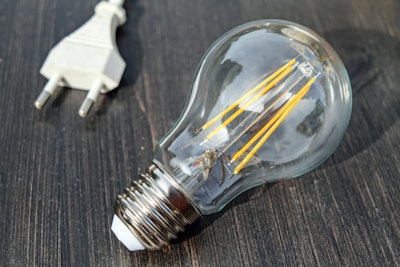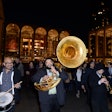
Power 101
This is actually not nearly as complicated as it might seem. Power requirements are determined using three elements:
Watts
Watts measure the amount of energy a device uses. If you've switched to LED bulbs in your home recently, you may have noticed that the LED replacement for the old 60 watt incandescent bulb now only uses 10 or 11 watts of energy to produce the same light output. (Light output is measured in lumens, but that's for another article.)
-
Responsibility: Knowing how many watts your various vendors will need is something you can tell the venue.
Amps
Amps measure the amount of electricity an electrical circuit can deliver. Just because you see an empty wall socket doesn't mean the circuit can support your device. It depends on how many amps that circuit can handle.Too many devices (or a few high-use devices: hairdryers, anyone?) will cause the circuit to overload and shut down.
-
Responsibility: Knowing how many amps are on a circuit, and where the outlets on that circuit are, is something the venue can tell you and your vendors. If you're getting additional power lines run for your event needs or those of your exhibitors, the venue should specify how many amps that circuit will be, and how many total watts it can accommodate.
Bonus credit for science geeks: To determine the amount of watts available on a given circuit multiply amps by volts. A 10 amp circuit at the standard U.S. 110 volts equals 1,100 total available watts that can be pulled from any combination of outlets on that circuit.
Volts
Volts are a measure of electrical pressure or the speed with which the electricity is delivered.
-
Responsibility: In most cases you won’t have to worry about this because it's fixed, with U.S. outlets at 110 to 120 volts, and most European outlets at 230 to 240 volts.
What Uses Power at Events?
Most modern events require electricity. To calculate the amount of electricity you'll need, add up the wattage for every single device that plugs into an outlet. Here's a sample list of things you might encounter:
- Functional lighting (check-in table, auction items, product displays, etc.)
- Design lighting
- Audio (sound system for speakers, DJ, band, etc.)
- Display (projectors, monitors)
- Guest device charging strips
- Photo booths
- Laptops and printers (check-in, backstage)
- Light-up furniture
- Catering equipment (e.g. coffee urns)
- Exhibitors
- Experiential activities
- Heating and ventilation (in tents)
Tips
A rough estimate of your power requirements can help you determine whether the venue you're considering is able to accommodate your event. Electricity can be a big line item on an event budget. It's important to be able to estimate a cost you can't do without. Many vendors often just plug their cords into the nearest outlet without consideration of how many amps that circuit can handle. Have the venue staff point out which outlets are on which circuits, and how many amps those circuits supply. Ensure your vendors communicate with each other to avoid blowing a circuit during the event. (It's unlikely you'll have all power being used during rehearsals or set-ups as vendors test their gear at different times.)
Learn More About This Topic
Power & Generators for Your Events: What You Need to Know, On-Demand Video Class with Brandt Krueger


















